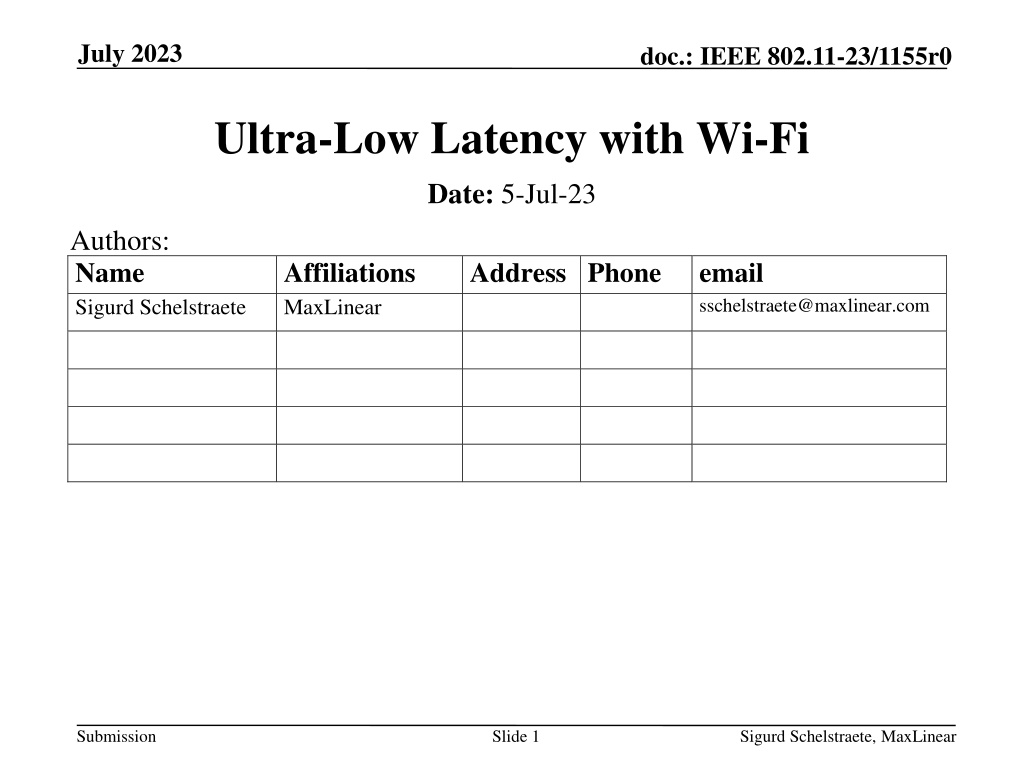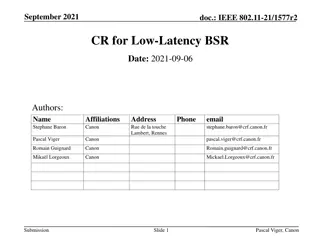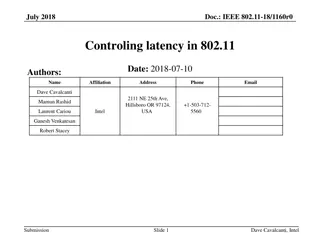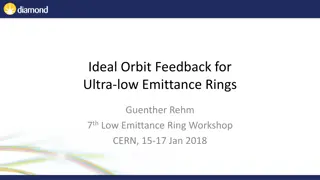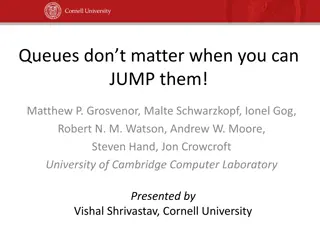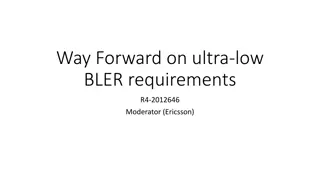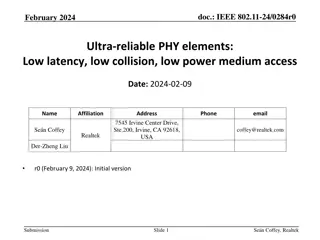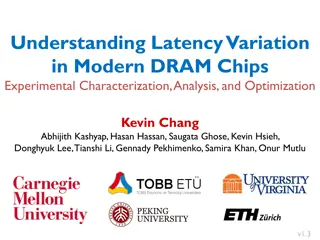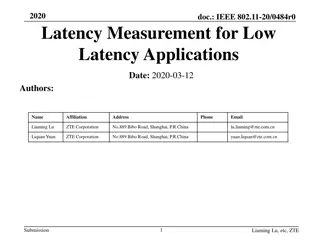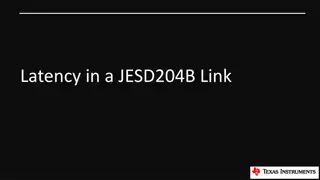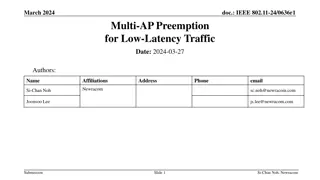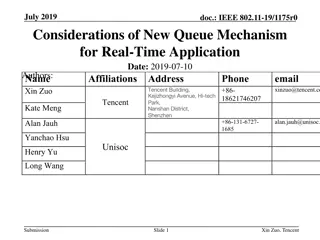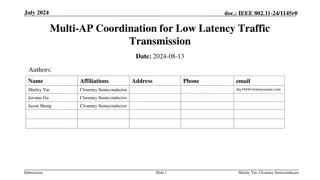Ultra-Low Latency with Wi-Fi
This document delves into the inherent latency issues within Wi-Fi networks, exploring the various delays introduced at different stages of data transmission. From contention delays to medium occupancy effects, the hurdles to achieving ultra-low latency in Wi-Fi communication are discussed in detail.
Download Presentation

Please find below an Image/Link to download the presentation.
The content on the website is provided AS IS for your information and personal use only. It may not be sold, licensed, or shared on other websites without obtaining consent from the author.If you encounter any issues during the download, it is possible that the publisher has removed the file from their server.
You are allowed to download the files provided on this website for personal or commercial use, subject to the condition that they are used lawfully. All files are the property of their respective owners.
The content on the website is provided AS IS for your information and personal use only. It may not be sold, licensed, or shared on other websites without obtaining consent from the author.
E N D
Presentation Transcript
July 2023 doc.: IEEE 802.11-23/1155r0 Ultra-Low Latency with Wi-Fi Date: 5-Jul-23 Authors: Name Sigurd Schelstraete Affiliations MaxLinear Address Phone email sschelstraete@maxlinear.com Submission Slide 1 Sigurd Schelstraete, MaxLinear
July 2023 doc.: IEEE 802.11-23/1155r0 Introduction Low latency is one of the goals of UHR Most current latency-sensitive use cases appear to require latency of the order of milliseconds Might be achieved by suitable scheduling and priorities Some forward-looking proposals [1, 2] suggest a need for latency 0.1 to 1 msec Microsecond latency also appears to be a preliminary goal for 6G NOTE: this is end-to-end latency, not just Wi-Fi latency Can Wi-Fi realistically achieve latencies of this order of magnitude? Submission Slide 2 Sigurd Schelstraete, MaxLinear
July 2023 doc.: IEEE 802.11-23/1155r0 Wi-Fi Inherent delays Wi-Fi channel access and PPDU structure by themselves incur an inherent latency of over 100 usec As measured between data available at Tx and data available at Rx Even when the medium is not occupied and traffic has been prioritized over everything else, there is no instantaneous access to the medium Submission Slide 3 Sigurd Schelstraete, MaxLinear
July 2023 doc.: IEEE 802.11-23/1155r0 Contributors to inherent delay Contention Typically, contention starts after the availability of data No reason to contend with empty buffer This adds delay before Transmitter can access the medium Contention time of the order of 100 300 usec (depending on AC) Preamble After gaining access to the medium, preamble will consume airtime before the data field carrying the actual data can be transmitted Typical value ~50 usec Transfer time Receiver can only process data after last bit has been received Function of data length and PHY rate Submission Slide 4 Sigurd Schelstraete, MaxLinear
July 2023 doc.: IEEE 802.11-23/1155r0 Additional delays When the medium is occupied, delays will be higher still Medium Busy Preamble LL payload Data Field Contention starts Contention ends Data on air Data available at receiver Data arrives Delay Waiting for Medium to become idle adds extra delay In addition to inherent delays Submission Slide 5 Sigurd Schelstraete, MaxLinear
July 2023 doc.: IEEE 802.11-23/1155r0 Problem statement How can we reduce the effects of inherent delays? For both predictable and unpredictable types of latency-sensitive traffic Assuming other sources of latency (scheduling, ) have been addressed Goal: Make data access to the medium near-instantaneous from the application perspective, while preserving 802.11 Medium Access protocols. Submission Slide 6 Sigurd Schelstraete, MaxLinear
July 2023 doc.: IEEE 802.11-23/1155r0 Possible solution for predictable traffic When traffic arrival times are (somewhat) predictable: Pre-contend such that the data field starts on the medium as close as possible to expected arrival of traffic at the transmitter Contention starts before data is available at transmitter Contention starts Preamble LL payload Data Field Contention ends Data on air Data available at receiver Data arrives Delay NOTE: the transmitter still contends as required by the standard No special access privileges to the medium! Contention will require the same amount of time, but is started ahead of the availability of traffic (based on expected traffic) Submission Slide 7 Sigurd Schelstraete, MaxLinear
July 2023 doc.: IEEE 802.11-23/1155r0 Managing unpredictability Exact contention duration is unpredictable (and possibly data arrival times may have jitter as well) Data may arrive before or after the start of the PPDU Data Field What to do if data arrives after start of Data Field? Start of Data Field Contention starts Preamble Data Field ?? Contention ends Data arrives Submission Slide 8 Sigurd Schelstraete, MaxLinear
July 2023 doc.: IEEE 802.11-23/1155r0 Pre-padding If no data is available, start of Data Field needs to be padded until data arrives Could be similar to EOF padding or MPDU start spacing Empty delimiters that will be filtered out at receiver Submission Slide 9 Sigurd Schelstraete, MaxLinear
July 2023 doc.: IEEE 802.11-23/1155r0 Reducing inherent latency for predictable traffic: summary Early contention : Choose start of contention judiciously to make arrival of data coincide as closely as possible with start of the Data Field Eliminate contention delay and preamble delay Indicate tentative PPDU duration in preamble Long enough to make sure PPDU fully covers expected arrival of data Pre-padding allows starting a PPDU before the actual arrival of data, as well as insertion of data into a PPDU in progress To avoid taking up excessive airtime, this could be combined with preemption PPDU is terminated as soon as all expected data has been processed Slide 10 Submission Sigurd Schelstraete, MaxLinear
July 2023 doc.: IEEE 802.11-23/1155r0 Reducing inherent latency for predictable traffic Contention ends Data arrives Contention starts Empty Empty Empty A-MPDU SF A-MPDU SF Termination Preamble SF SF SF MAC padding until data is available Preempt: End packet when all expected data is processed Start packet with tentative duration Data Contend early Submission Slide 11 Sigurd Schelstraete, MaxLinear
July 2023 doc.: IEEE 802.11-23/1155r0 Simulations predictable traffic Assume LL traffic always wins access to the medium around expected traffic arrival events E.g., through rTWT Traffic is periodic, but allow some jitter in the exact arrival time Compare 95th percentile latency: 1. regular channel access (contention starts after data arrival) AC_BE and AC_VO 2. Proposed method Early contention + early termination Simulation models contention, data arrival, Discrete event simulation Submission Slide 12 Sigurd Schelstraete, MaxLinear
July 2023 doc.: IEEE 802.11-23/1155r0 Results (p95) Predictable traffic Traffic 100 Hz burst 5% jitter on expected arrival times 160 Bytes/burst LL traffic sent at MCS 0 or MCS 9 Affects transfer time Significant reduction in end-to-end latency (as seen by application) Submission Slide 13 Sigurd Schelstraete, MaxLinear
July 2023 doc.: IEEE 802.11-23/1155r0 Non-predictable traffic The method described earlier can not be used when traffic arrival times are unknown No notion of right time to start contention However, a similar approach could be used in combination with OFDMA Assign an RU for LL traffic (representing a relatively small part of the total BW) whether traffic is available or not at the time the PPDU starts Pre-pad the reserved RU and insert LL traffic if/when it arrives Submission Slide 14 Sigurd Schelstraete, MaxLinear
July 2023 doc.: IEEE 802.11-23/1155r0 Non-predictable traffic Submission Slide 15 Sigurd Schelstraete, MaxLinear
July 2023 doc.: IEEE 802.11-23/1155r0 Simulations unpredictable traffic In 160 MHz BSS, reserve 242-tone RU for LL services Pre-padding if no LL data available NOTE: in this case, other DL traffic can run concurrently Submission Slide 16 Sigurd Schelstraete, MaxLinear
July 2023 doc.: IEEE 802.11-23/1155r0 Results (p95) unpredictable traffic Notes Latency without pre-padding dominated by PPDU duration Longer transfer delay caused by smaller BW (20 MHz) 95 percentile increased due to possibility of LL traffic arriving outside of data field Submission Slide 17 Sigurd Schelstraete, MaxLinear
July 2023 doc.: IEEE 802.11-23/1155r0 Observations Overall latency can be significantly reduced Eliminate most of the inherent delays (from application perspective) Contention unchanged Remaining latency dominated by packet transfer time (function of PHY rate) and modulation OFDM with 16 usec symbols Further lowering the latency might require changes to modulation Implementation specific delays were not considered E.g., execution time of FFT/IFFT Data arrival at Tx vs. availability for MAC Results should be considered lower bound Submission Slide 18 Sigurd Schelstraete, MaxLinear
July 2023 doc.: IEEE 802.11-23/1155r0 Conclusions We discussed techniques to minimize inherent Wi-Fi delays for LL traffic Start contention at a suitable time before expected data availability (predictable traffic) Insert padding at start of data field if needed Early PPDU termination if needed Using some or all of these techniques, inherent latency from Wi-Fi can be significantly reduced Early contention appears compatible with current channel access Pre-padding appears compatible with existing A-MPDU padding Should there be rules on when to use it? Submission Slide 19 Sigurd Schelstraete, MaxLinear
July 2023 doc.: IEEE 802.11-23/1155r0 References [1] 11-22-0032-00-0wng-next-gen-after-11be [2] 11-22-0046-01-0wng-next-generation-after-802-11be [3] 11-23-0610-01-0uhr-low-latency-traffic-delivery-in-uhr Submission Slide 20 Sigurd Schelstraete, MaxLinear
